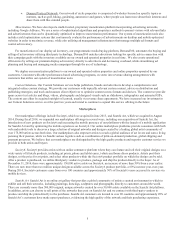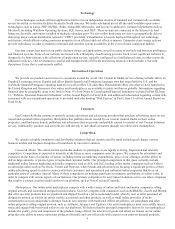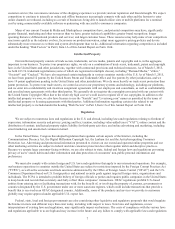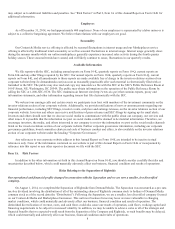Enom 2014 Annual Report Download - page 17
Download and view the complete annual report
Please find page 17 of the 2014 Enom annual report below. You can navigate through the pages in the report by either clicking on the pages listed below, or by using the keyword search tool below to find specific information within the annual report.14
• Distributed Content Creation Platforms. We compete with companies that employ a content creation model with aspects
similar to our platform, such as NewsCred and Contently, including for the creation of content for third-parties.
We may be subject to increased competition in the future if any of these competitors devote increased resources to more directly
address the online market for the professional creation of content. For example, if Google chose to compete more directly with us, we
may face the prospect of the loss of business or other adverse financial consequences given that Google possesses a significantly
greater consumer base, financial resources, distribution channels and patent portfolio. In addition, should Google decide to directly
compete with us in areas such as content creation, it may decide for competitive reasons to terminate or not renew our commercial
agreements and, in such an event, we may experience a rapid decline in our revenue from the loss of our source for advertising on our
owned and operated online properties and on our customers’ online properties. In addition, Google’s access to more comprehensive
data regarding user search queries through its search algorithms would give it a significant competitive advantage over everyone in the
industry, including us. If this data is used competitively by Google, sold to online publishers or given away for free, our business may
face increased competition from companies, including Google, with substantially greater resources, brand recognition and established
market presence.
In addition to Google, many of our current and other potential competitors for our Content & Media service offering enjoy
substantial competitive advantages, such as greater name recognition, longer operating histories, substantially greater financial,
technical and other resources and, in some cases, the ability to combine their online marketing products with traditional offline media
such as newspapers or magazines. These companies may use these advantages to offer products and services similar to ours at a lower
price, develop different products to compete with our current offerings and respond more quickly and effectively than we can to new
or changing opportunities, technologies, standards or customer requirements. For example, both AOL and Yahoo! may have access to
proprietary search data which could be utilized to assist them in their content creation processes. In addition, many of our current and
potential competitors have established marketing relationships with and access to larger customer bases. Due to this intense
competition, we may be unable to maintain or improve our competitive position or market share in the content and media business.
Marketplaces
Our Marketplaces service offering competes with a wide variety of online and brick-and-mortar companies selling original
artwork and customized design-focused products. Society6 competes with companies, such as RedBubble, Zazzle and Minted, that
offer specialty products that are produced and shipped based on a print-on-demand model, whereby user or artist generated art designs
are printed on t-shirts, art prints, mobile accessories and other products, as well as small online providers of niche customization
services and product offerings. Saatchi Art competes with traditional offline art galleries, art consultants and other online properties
selling original artwork, such as Artfinder, Artspace and Ugallery. We expect competition to continue to intensify as online and offline
businesses increasingly are competing with each other, and because the barriers to entry into online channels can be low. Businesses
can launch online sites or mobile platforms and applications for a nominal cost by using commercially-available software or
partnering with successful e-commerce companies.
Both of our artist marketplaces must successfully attract, retain and engage both buyers and sellers to use our platforms. We
believe that the principal competitive factors for our marketplaces include the quality, price and uniqueness of the products being
offered; the selection of goods and artists featured on our online properties; the ability to source numerous products efficiently and
cost-effectively with respect to our print-on-demand products; customer service; the convenience and ease of the shopping experience
we provide; and our reputation and brand strength.
Many of our current competitors for our artist marketplaces have, and potential competitors may have, longer operating
histories, larger customer bases, greater technical capabilities, and significantly greater financial, marketing and other resources than
we have. Some of our competitors may offer or continue to offer faster and/or free shipping, favorable return policies or other
transaction-related services which improve their user experience, but which could be impractical or inefficient for our sellers to match.
Some of our competitors may be able to use the advantages of brick-and-mortar stores or other sorts of physical presence to build their
customer bases and drive sales. These factors may allow our competitors to derive greater net sales and profits from their existing
customer base, acquire customers at lower costs, use incentive programs to acquire our customers, or respond more quickly than we
can to new or emerging technologies and changes in consumer habits. These competitors may engage in more extensive research and
development efforts, undertake more far-reaching marketing campaigns and adopt more aggressive pricing policies, which may allow
them to build larger customer bases or generate net sales from their customer bases more effectively than we do. For all of these
reasons, we may not be able to compete successfully against the current and potential competitors to our artist marketplaces.
























